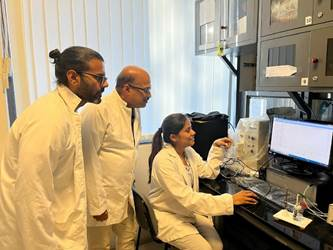Context:
Researchers have developed a new efficient High-Entropy Alloy (HEA) catalyst called PtPdCoNiMn for improved hydrogen production through the electrolysis of water into hydrogen and oxygen.
More on the News

- Research was done at the Centre for Nano and Soft Matter Sciences (CeNS) in Bengaluru an autonomous institute of the Department of Science and Technology (DST).
- The research was funded by India’s Anusandhan National Research Foundation (ANRF), of which the Department of Science and Technology (DST) is the administrative Department.
- Two papers from the research were recently published in the journals Advanced Functional Material and Small.
About the new catalyst “PtPdCoNiMn”
The PtPdCoNiMn HEA catalyst was created by combining the following metals: –
- Platinum (Pt),
- Palladium (Pd),
- Cobalt (Co),
- Nickel (Ni), and
- Manganese (Mn)
Key features:
- The catalyst used seven times less platinum than commercial catalysts.
- It outperformed pure platinum in catalytic efficiency.
- It also displayed good performance in practical settings, including alkaline seawater by maintaining stability and efficiency for over 100 hours without degradation.
- It resulted in efficient hydrogen production with minimal energy loss, high durability, and long-term stability.
Synthesis Methods:
The selection of these constituent metals was based on guidelines designed and developed by Dr. Prashant Singh, a Staff Scientist from AMES National Laboratory, USA.
The researchers at CeNS created the HEA using two methods:
- Electrodeposition at room temperature and pressure, and
- Chemical synthesis through solvothermal processes at high temperature and pressure in given solvent.
Significance of this new catalyst:
- This advancement could pave the way for cleaner, more affordable hydrogen production, benefiting industries and renewable/clean energy technologies and helping India achieve its ambitious targets of energy independence by 2047 and net-zero emission by 2070 through sustainable production of green hydrogen.
About Green Hydrogen
- It is produced via electrolysis, where water is split into hydrogen and oxygen using electricity generated from renewable energy sources such as solar, wind, or hydroelectric power.
- It is environmentally friendly and sustainable, as it does not produce CO2 emissions during production.
- It is considered the cleanest form of hydrogen and plays a crucial role in decarbonizing various sectors.
- Another method of producing Green Hydrogen is from biomass, which involves the gasification of biomass to produce hydrogen.
Green Hydrogen Initiatives in India
National Green Hydrogen Mission (2023): It aims to make India a Global Hub for the production, utilization, and export of Green Hydrogen and its derivatives, by targeting the production of 5 MMT per annum of Green Hydrogen by 2030. The following components have been announced as part of the Mission:
- Strategic Interventions for the Green Hydrogen Transition (SIGHT) program, which includes incentives for the manufacturing of electrolysers and the production of green hydrogen;
- Development of Green Hydrogen Hubs;
- Pilot Projects for steel, mobility, shipping, decentralized energy applications, hydrogen production from biomass, hydrogen storage, etc.
NTPC Limited has initiated blending of Green Hydrogen up to 8% (vol/vol) in PNG Network at NTPC Kawas Township, Surat, Gujarat from January 2023.
Oil India Limited (OIL) recently commissioned India’s first 99.999% pure green hydrogen plant in Jorhat, Assam, marking a milestone in the nation’s green energy journey.
Pune Municipal Corporation has partnered with The Green Billions (TGBL) to convert waste into green hydrogen, demonstrating the potential for waste-to-energy projects.

